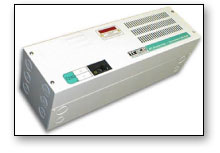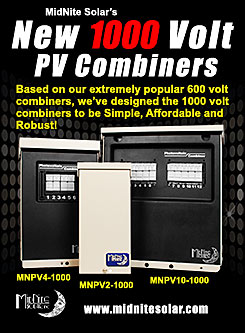Trace AC box / T-240
Well, the house got built and the Trace AC box / T-240
did in fact make it into the Power Panel, but I have
the only Trace split apart back panel in existence!
Trace decided not to offer the back panel as a separate
piece. The AC box as it was called when mounted on
the Power Panel also had room for the T-240. This
box had room for two AC bypass switches as well as
AC input breakers and the T-240 breakers. The T-240
was used only for single systems as it was for step
up or step down only. One thing we did when converting
the old T-220 into the new T-240 was to get rid of
all those taps. I never did figure out how to wire
theT-220, so the new T-240 got rid of all the wires
that weren’t really necessary. I also never figured
out why Trace would not sell the AC box without the
autoformer?
A few more years go by, a few more inverters are designed
and then on July 31, 2000 the new owners of Trace,
(Xantrex), decided to lay me off. As you can imagine,
I was not pleased that Xantrex had laid off their
chief mechanical engineer in Arlington, especially
since I had paid for and owned about 1% of the company.

The very next day while filing for unemployment I
decided that there were still too many good ideas
swimming around in my head, so I was just going to
have to start my own company and compete with Xantrex.
Enter OutBack Power Systems!
The first ten months was spent in my home office designing
sheet metal boxes to go with the FX inverter as well
as the Trace DR, SW and Vanner RE series inverters.
The OutBack inverter was still two years away from
production, but the mechanical design was being worked
on. By the time I rented a building in June 2001,
the FX inverter mechanical design was virtually done.
It would still be another 18 months before it worked
well enough electrically to ship.
The OutBack PSAC and PSDC were designed during that
first six months of solitude in my home office. I
had the chance to start with a clean slate and therefore
was able to address some industry shortcomings that
needed attention. The first thing to address was to
allow ample room for wiring. Compare the size of the
AC and DC boxes between the OutBack Power Panel and
the other popular breaker boxes. Big difference! There
were a host of other improvements too. The Quad stack
is the most versatile power center ever developed,
but if you do not need all that capability, OutBack
did not have a smaller solution. The OutBack enclosures
se breakers that previously were not used in the
AE industry. Square D breakers did not always fit
the bill due to size, cost and DC voltage limitations,
so new sizes and styles were in order. The decision
to expand on breaker styles has been a good thing
for our industry. We now have good small and inexpensive
breakers rated for 125VDC. The AC equivalents are
also small and economical.

OutBack PSAC, PSDC, PSMP
To address the size, weight and cost issue of the
quad stack, I developed the OutBack PS2 system about
a year later. This has grown to be the industry standard
for dual inverter systems.

OutBack PS2 System
While the PS2 system enjoys great acceptance in North
America, it is virtually non existent in Europe, Africa,
Australia and New Zealand. There are a couple of reasons
for this. It is physically too large for European
homes. It uses breakers not available outside of North
America, it is expensive and it looks too American.




